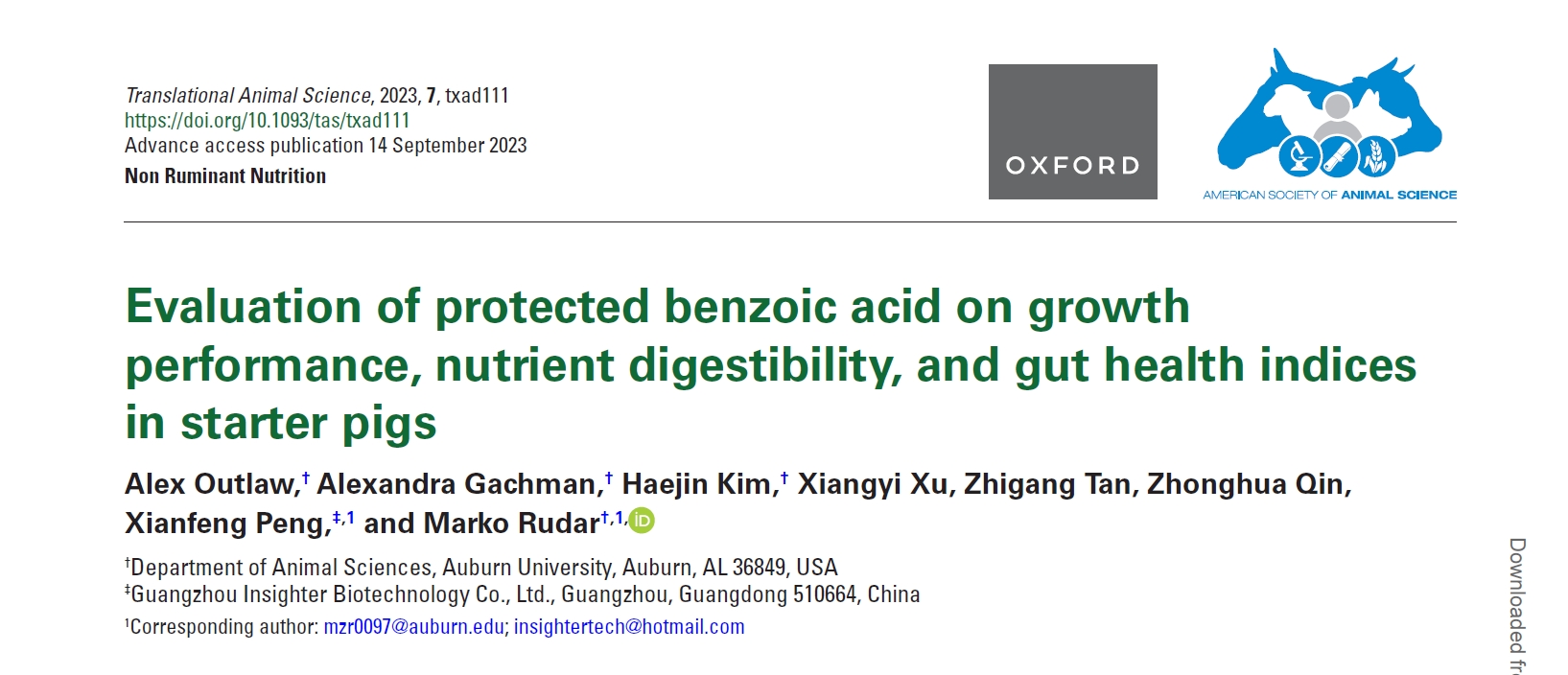【Publication】The study of the Benzocal-50 in starter pigs was published in the journal Translational Animal Science
2024年4月18日可肥酸-50仔猪饲养实验报告在Translational Animal Science杂志发表


Evaluation of protected benzoic acid on growth performance, nutrient digestibility, and gut health indices in starter pigs
Alex Outlaw1, Alexandra Gachman1, Haejin Kim1, Xiangyi Xu, Zhigang Tan, Zhonghua Qin, Xianfeng Peng 2,* , and Marko Rudar1,*
1 Department of Animal Sciences, Auburn University, Auburn, AL 36849, USA
2 Guangzhou Insighter Biotechnology Co., Ltd., Guangzhou, Guangdong 510664, China
3 Corresponding author: mzr0097@auburn.edu; insightertech@hotmail.com
Abstract
Benzoic acid is a common alternative for antibiotic and zinc oxide use in nursery diets. Free benzoic acid (BZA) is often supplied, but this form is absorbed before it can exert any effect on distal segments of the gut. The study aimed to evaluate the effects of protected benzoic acid on growth performance, nutrient digestibility, plasma metabolites, and gut health indices in starter pigs. A total of 192 pigs were weaned at 28 ± 1 d age (initial body weight, 8.72 ± 1.13 kg). Pens were assigned to one of four treatment diets (n = 8 pens per treatment): (1) no additive (NC), (2) free benzoic acid (BZA; 0.6%), (3) protected benzoic acid (BC50; 0.2%, supplied at a ratio of one to three equivalents of BZA), and (4) antibiotic growth promoter (AGP; Carbadox, 50 ppm). Diets were fed for three weeks over two periods (period 1, 7 d; period 2, 14 d). Body weight and feed intake were measured for each period. Feces were collected at the end of each period to determine apparent total tract digestibility (ATTD) of organic matter (OM), gross energy (GE), and crude protein (CP). One pig per pen was euthanized per period to determine plasma metabolites; jejunum and ileum morphology; jejunum, ileum, and colon cytokine abundance; and jejunum, ileum, and colon tight junction protein expression. The AGP group had increased average daily gain (ADG) and average daily feed intake (ADFI) compared to other groups in period 1 and overall (P < 0.05); however, ADG and ADFI of the BC50 group was intermediate between the NC and BZA groups and the AGP group in period 2. The ATTD of OM, GE, and CP were greater in the AGP group compared to the NC and BC50 groups (P < 0.05), whereas the BZA group was intermediate. Jejunum and ileum villus height and crypt depth increased from period 1 to period 2 (P < 0.01) but were similar across groups. Ileum and colon tumor necrosis factor-α (TNF-α) abundances were greater, whereas colon interleukin (IL)-1β and colon and ileum IL-8 abundances were less, in the AGP group compared to the BZA group (P < 0.05); the NC and BC50 groups exhibited intermediate TNF-α, IL-1β, and IL-8 abundance in the ileum and colon. Jejunum cytokine abundance did not vary among groups but declined from period 1 to period 2 (P < 0.05). Tight junction protein expression also did not vary among groups. In summary, protected BZA supported a slight increase in growth performance in starter pigs, suggesting its potential as an alternative feed additive in nursery diets.
Key words: benzoic acid, cytokine, digestibility, intestine, pig, weaning




